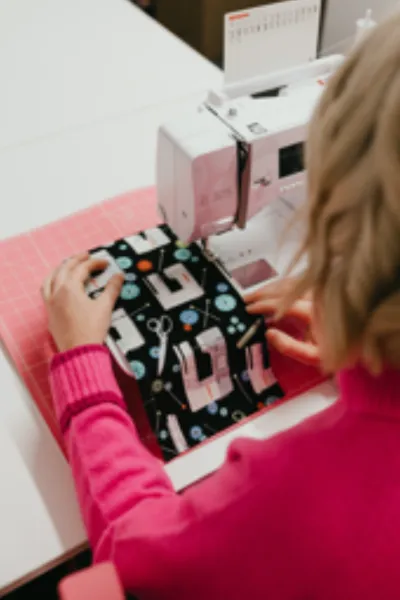
Give Fabric another life: How to sew sustainably with pre-loved textiles
Every year, mountains of textiles end up in landfill, often still full of life and potential. As sewists, we can change that. Choosing recycled or pre-loved fabrics is more than a budget-saving trick, it’s a creative choice that celebrates sustainability and craftsmanship.
One of my favourite makes began with an embroidered tablecloth which was my great-grandmothers. It was tucked away in a drawer, rarely seen. By turning it into a breezy summer top, I gave her handiwork a new purpose and kept a piece of family history alive. Wearing it now feels like a connection across generations and I am forever being asked about where I got it.

Our "Me made May" Event-Customers and staff in their home crafted garments.
(I'm centre in my tablecloth top)
Why Choose Recycled or Pre-Loved Fabrics?
Environmental Impact: Every reused metre of fabric is one less going to waste and one less newly manufactured.
Budget-Friendly: Vintage duvet covers or charity shop curtains can cost a fraction of new meterage.
Unique Character: Pre-loved textiles carry stories, faded florals, hand embroidery, or retro prints you won’t find in the shops.
One of a kind: You'll never go to an event where someone will be wearing the same as you!
Globally, the fashion and textile industry produces over 90 million tonnes of waste each year, much of which ends up in landfill or incinerators. In the UK alone, an estimated 350,000 tonnes of wearable clothing is discarded annually. Most of these textiles are made from resource-intensive fibres like cotton or polyester, which take huge amounts of water and energy to produce and can take decades to break down.

By reusing even a single duvet cover or tablecloth, you’re helping reduce that waste stream, turning what could have been landfill into something functional and beautiful.
Where to Source Your Next Treasure
Charity Shops & Thrift Stores: Look beyond the clothing racks—curtains, sheets, and even large garments can yield plenty of fabric.
De-Stash Events (This Month!): Our de-stash event is happening this month. Buy pre-loved at bargain prices. It’s a brilliant way to refresh your stash, meet fellow makers, and keep textiles circulating rather than sending them to landfill. Don’t miss the chance to pick up unique finds and inspiration.
Your Own Linen Closet: Old duvet covers, pillowcases, or tablecloths are perfect for toiles, linings, or finished garments.
Old Linen Tea Towels: Vintage or printed tea towels can be transformed into tops, sturdy tote bags, aprons, or patchwork panels.

Prepping Your Fabric for Sewing
Wash Thoroughly: Remove any labels, dust, or odours and check for shrinkage.
Inspect for Wear: Avoid weak spots or stains unless you plan to work around them creatively. (Stains can be common in tablecloths, so check them out before you make a start.)
Press & Square Up: Iron your fabric flat and re-square it if it’s stretched or warped from previous use, I like to use a gentle spray starch on old linens to refresh them.
Project Ideas to Try
Garments: Oversized shirts, tiered skirts, wrap dresses, or tops with contrasting panels from patchwork.
Home Décor: Cushion covers, bunting, or quilted throws using mixed pre-loved fabrics.
Accessories: Tote bags, aprons, or zip pouches are great for smaller pieces or scraps. Tea towels work beautifully here, especially for bags or aprons.
Recycled fabrics aren’t second-best, they’re full of history, character, and possibility. The next time you reach for a new metre of fabric, challenge yourself to find a forgotten treasure instead, or better yet, join us at this month’s de-stash event and discover your next project waiting on someone else’s fabric table. Saturday 20th September 2025 10-1pm.
Sew what you love, create without limits ❤️
